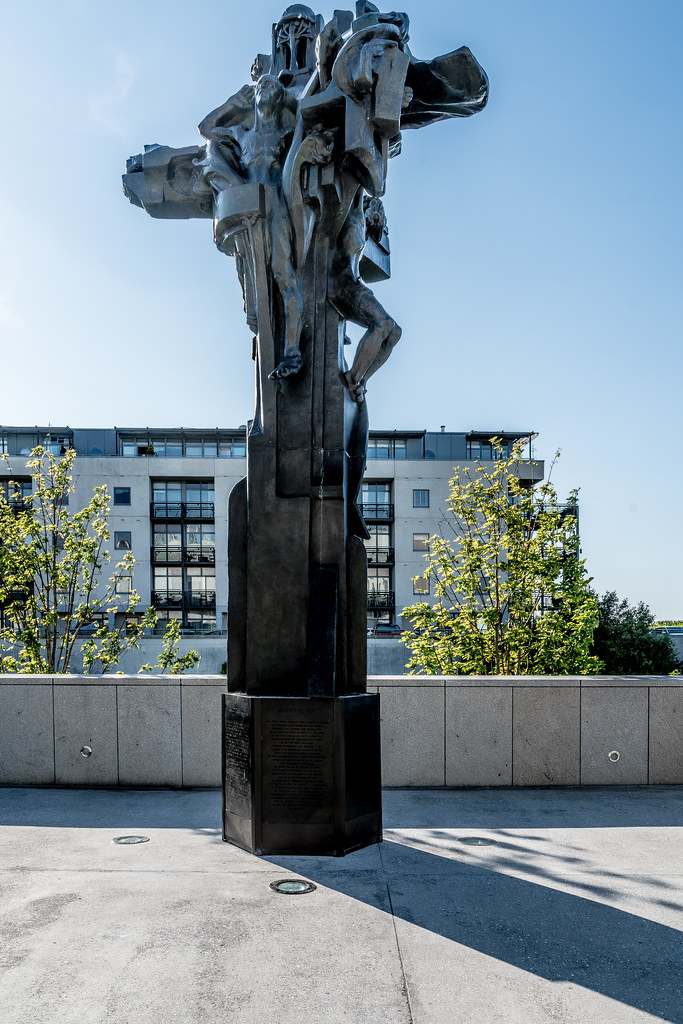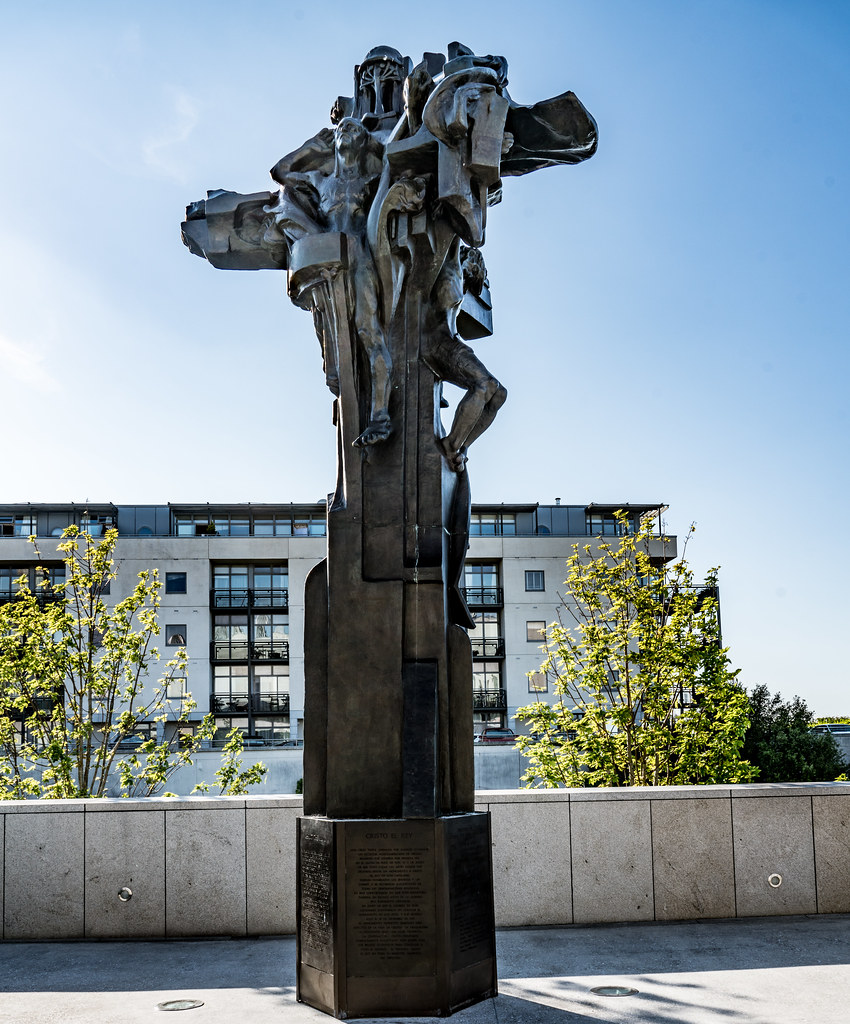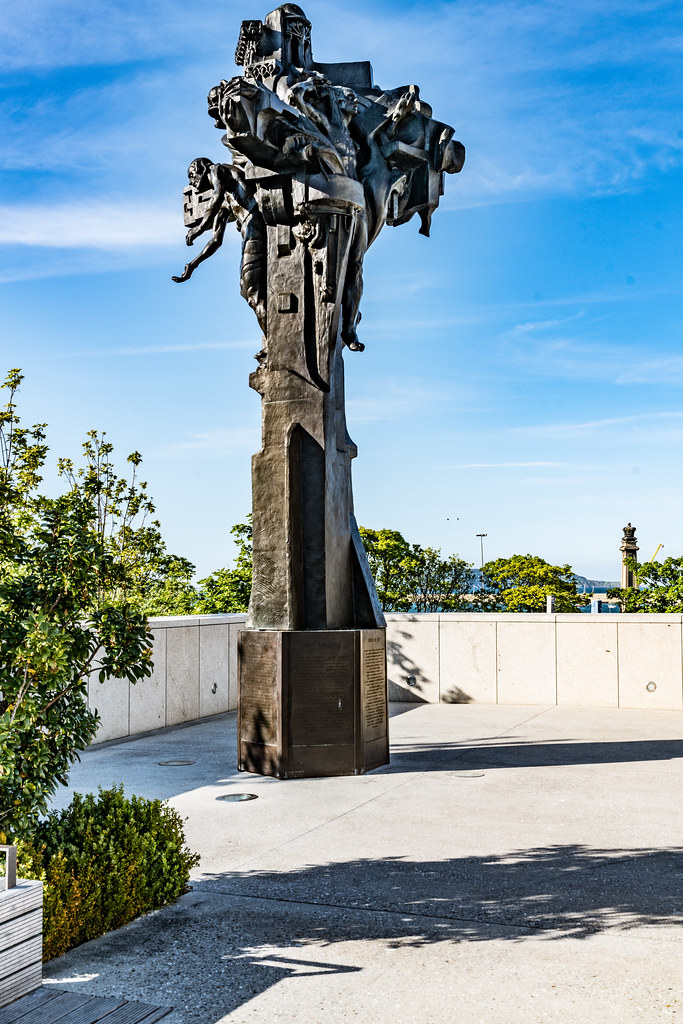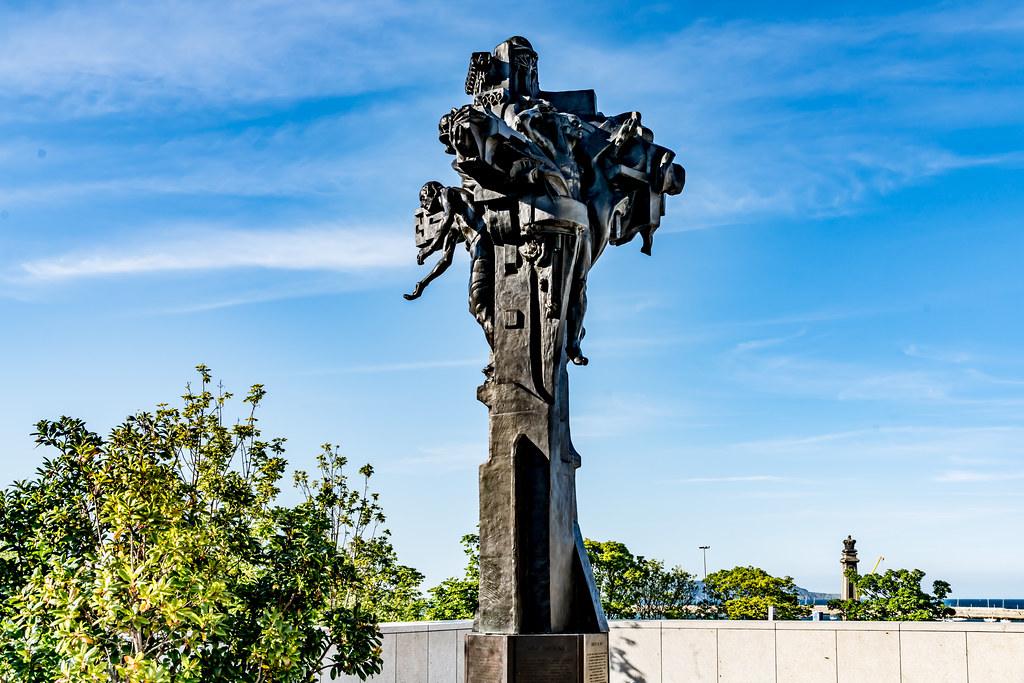CHRIST THE KING
The "Triple Cross" of Christ the King, symbolising the three distinct aspects of Christ's life – Desolation, Consolation and Triumph – has been standing 18 feet high as a major landmark for the town, since it was formally unveiled in 1978.
The sculpture is 18 feet high and weighs approximately 3.5 tons. The three scenes depicted on the tall bronze pillar symbolise three distinct aspects of Christ’s life - desolation, consolation and triumph. A shrouded weary Jesus, crucified on the cross, the heavy canopy symbolising the day of gloom and despair; the resurrected Christ with arms outstretched; and Christ pulling clear of his bondage and emerging to greet his followers. These scenes follow clockwise around the mast of the pillar, the arms of the cross dividing them as we move down the piece. The sculpture narrows to angular sheets of bronze until we reach the large bronze plaques, which form the lower section.
The Christ the King Statue is by Andrew O’Connor, a well-known Irish American sculptor whose work is on display throughout the world. Among his best-known works are the statue of Abraham Lincoln in Springfield, Illinois; Peace by Justice in The Hague; Tristan and Iseult in the Brooklyn Museum and the Lafayette Monument in Baltimore. Based in Paris for many years, O’Connor was strongly influenced by Auguste Rodin, whom he knew. The sculpture now known as Christ the King and located in Dún Laoghaire was originally known as the Triple Cross. O’Connor entered the Triple Cross in a competition held by the French for a Monument to the Dead of the Great War. O’Connor was awarded the Legion d’Honneur for the Triple Cross. It was first exhibited, in plaster, at the Paris Salon of 1926.
According to a 1932 booklet the original idea for the erection of a sculpture in Dún Laoghaire came from a 1925 Encyclical Letter which instituted the Feast of Christ the King – to be held on the last Sunday of October.
In 1931 a group of laymen in Dún Laoghaire got together with a view to erecting a statue to honour the new feast day. Dún Laoghaire was regarded as the gateway to Ireland and thus a fitting place to raise such a significant monument. A committee was established to select and acquire a site for the sculpture. The selection criteria for the site was that there should be an uninterrupted view of the monument for ships entering and leaving the harbour as well as those traversing the bay and that there should be easy approach to those who wished to visit the site on land.
An appeal booklet appeared the following year announcing Andrew O’Connor as the committee’s choice of sculptor. The piece was eventually cast in bronze but World War II intervened and it was hidden in France to avoid its three tonnes being melted down. It was eventually delivered to Dún Laoghaire in 1949. However, due to local clerical opposition to the statue it was not erected and for many years was stored in a back garden on Rochestown Avenue. Eventually Christ the King was unveiled in the Haigh Terrace location on December 16, 1978 forty-seven years after the public meeting in the town hall. This location was not the originally intended location and came in for criticism at the time of the sculpture’s erection.
The sculpture is 18 feet high and weighs approximately 3.5 tons. The three scenes depicted on the tall bronze pillar symbolise three distinct aspects of Christ’s life - desolation, consolation and triumph. A shrouded weary Jesus, crucified on the cross, the heavy canopy symbolising the day of gloom and despair; the resurrected Christ with arms outstretched; and Christ pulling clear of his bondage and emerging to greet his followers. These scenes follow clockwise around the mast of the pillar, the arms of the cross dividing them as we move down the piece. The sculpture narrows to angular sheets of bronze until we reach the large bronze plaques, which form the lower section.
The Christ the King Statue is by Andrew O’Connor, a well-known Irish American sculptor whose work is on display throughout the world. Among his best-known works are the statue of Abraham Lincoln in Springfield, Illinois; Peace by Justice in The Hague; Tristan and Iseult in the Brooklyn Museum and the Lafayette Monument in Baltimore. Based in Paris for many years, O’Connor was strongly influenced by Auguste Rodin, whom he knew. The sculpture now known as Christ the King and located in Dún Laoghaire was originally known as the Triple Cross. O’Connor entered the Triple Cross in a competition held by the French for a Monument to the Dead of the Great War. O’Connor was awarded the Legion d’Honneur for the Triple Cross. It was first exhibited, in plaster, at the Paris Salon of 1926.
According to a 1932 booklet the original idea for the erection of a sculpture in Dún Laoghaire came from a 1925 Encyclical Letter which instituted the Feast of Christ the King – to be held on the last Sunday of October.
In 1931 a group of laymen in Dún Laoghaire got together with a view to erecting a statue to honour the new feast day. Dún Laoghaire was regarded as the gateway to Ireland and thus a fitting place to raise such a significant monument. A committee was established to select and acquire a site for the sculpture. The selection criteria for the site was that there should be an uninterrupted view of the monument for ships entering and leaving the harbour as well as those traversing the bay and that there should be easy approach to those who wished to visit the site on land.
An appeal booklet appeared the following year announcing Andrew O’Connor as the committee’s choice of sculptor. The piece was eventually cast in bronze but World War II intervened and it was hidden in France to avoid its three tonnes being melted down. It was eventually delivered to Dún Laoghaire in 1949. However, due to local clerical opposition to the statue it was not erected and for many years was stored in a back garden on Rochestown Avenue. Eventually Christ the King was unveiled in the Haigh Terrace location on December 16, 1978 forty-seven years after the public meeting in the town hall. This location was not the originally intended location and came in for criticism at the time of the sculpture’s erection.
LOADING




